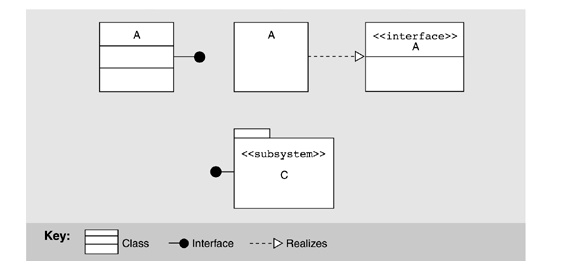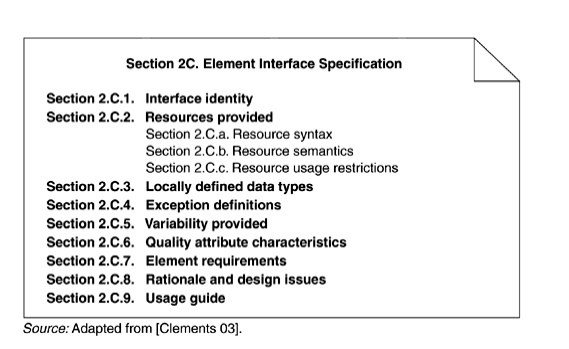Chapter: Software Architectures : Documenting the Architecture
Documenting Interfaces
DOCUMENTING INTERFACES
An interface is a boundary across which two
independent entities meet and interact or communicate with each other. Since
you cannot perform analyses or system building without them, documenting
interfaces is an important part of documenting architecture.
Documenting
an interface consists of naming and identifying it and documenting its syntactic
and semantic information. The first two parts constitute an interface's
"signature." When an interface's resources are invokable programs,
the signature names the programs and defines their parameters. Parameters are
defined by their order, data type, and (sometimes) whether or not their value
is changed by the program. A signature is the information that you would find
about the program, for instance, in an element's C or C++ header file or in a
Java interface.
Signatures
are useful (for example, they can enable automatic build checking), but are
only part of the story. Signature matching will guarantee that a system will
compile and/or link successfully. However, it guarantees nothing about whether
the system will operate successfully, which is after all the ultimate goal.
That information is bound up in the semantics to the interface, or what happens
when resources are brought into play.
An
interface is documented with an interface specification, which is a statement
of element properties the architect chooses to make known. The architect should
expose only what is needed to interact with the interface. Put another way, the
architect chooses what information is permissible and appropriate for people to
assume about the element, and what is unlikely to change. Documenting an
interface is a matter of striking a balance between disclosing too little
information and disclosing too much. Too little information will prevent
developers from successfully interacting with the element. Too much will make
future changes to the system more difficult and widespread and make the
interface too complicated for people to understand. A rule of thumb is to focus
on how elements interact with their operational environments, not on how they
are implemented. Restrict the documentation to phenomena that are externally
visible.
Elements
that occur as modules often correspond directly to one or more elements in a
component-and-connector view. The module and component-and-connector elements
are likely to have similar, if not identical, interfaces and documenting them
in both places would produce needless duplication. To avoid that, the interface
specification in the component-and-connector view can point to the interface
specification in the module view, and only contain the information specific to
its view. Similarly, a module may appear in more than one module view-such as
the module decomposition or uses view. Again, choose one view to hold the
interface specification and refer to it in the others.
A Template for Documenting Interfaces
Here
is a suggested standard organization for interface documentation. You may wish
to modify it to remove items not relevant to your situation, or add items
unique to it. More important than which standard organization you use is the
practice of using one. Use what you need to present an accurate picture of the
element's externally visible interactions for the interfaces in your project.
1.
Interface
identity. When an element has multiple interfaces, identify the individual interfaces to distinguish
them. This usually means naming them. You may also need to provide a version
number.
2.
Resources
provided. The heart of an interface document is the resources that
the element provides. Define them by
giving their syntax, their semantics (what happens when they are used), and any
restrictions on their usage. Several notations exist for documenting an
interface's syntax. One is the OMG's Interface Definition Language (IDL), used
in the CORBA community. It provides language constructs to describe data types,
operations, attributes, and exceptions. The only language support for semantic
information is a comment mechanism. Most programming languages have built-in
ways to specify the signature of an element. C header (.h)
files and Ada package specifications are two examples.
Finally,
using the <<interface>>
stereotype in UML (as shown in Figure
9.4) provides the means for conveying syntactic information
about an interface. At a minimum, the interface is named; the architect can
also specify signature information.
o
Resource
syntax. This is the resource's signature. The signature includes any information another program will
need to write a syntactically correct program that uses the resource. The
signature includes the resource name, names and logical data types of arguments
(if any), and so forth.
o
Resource
semantics. This describes the result of invoking the resource. It might include
-
assignment of values to data that the actor invoking the
resource can access. It might be as simple as setting the value of a return
argument or as far-reaching as updating a central database.
-
events that will be signaled or messages that will be
sent as a result of using the resource.
-
how other resources will behave in the future as the
result of using this resource. For example, if you ask a resource to destroy an
object, trying to access that object in the future through other resources will
produce quite a different outcome (an error).
-
humanly observable results. These are prevalent in
embedded systems; for example, calling a program that turns on a display in a
cockpit has a very observable effect: The display comes on.
In addition, the statement of semantics should make it clear whether the resource
execution will be atomic or may be suspended or interrupted. The most
widespread notation for conveying semantic information is natural language.
Boolean algebra is often used to write down preconditions and postconditions,
which provide a relatively simple and effective method for expressing
semantics. Traces are also used to convey semantic information by writing down
sequences of activities or interactions that describe the element's response to
a specific use.
o
Resource
usage restrictions. Under what circumstances may this resource be used? Perhaps data must be
initialized before it can be read, or a particular method cannot be invoked
unless another is invoked first. Perhaps there is a limit on the number of actors
that can interact via this resource at any instant. Perhaps only one actor can
have ownership and be able to modify the element whereas others have only read
access. Perhaps only certain resources or interfaces are accessible to certain
actors to support a multi-level security scheme. If the resource requires that
other resources be present, or makes other assumptions about its environment,
these should be documented.
-
Figure 9.4.
Interfaces in UML

3.
Data
type definitions. If any interface resources employ a data type other than one provided by the underlying
programming language, the architect needs to communicate the definition of that
data type. If it is defined by another element, then a reference to the
definition in that element's documentation is sufficient. In any case,
programmers writing elements using such a resource need to know (a) how to
declare variables and constants of the data type; (b) how to write literal
values in the data type; (c) what operations and comparisons may be performed
on members of the data type; and (d) how to convert values of the data type
into other data types, where appropriate.
4.
Exception
definitions. These describe exceptions that can be raised by the resources on the interface. Since the
same exception might be raised by more than one resource, it is often
convenient to simply list each resource's exceptions but define them in a
dictionary collected separately. This section is that dictionary. Common
exception-handling behavior can also be defined here.
5.
Variability
provided by the interface. Does the interface allow the element to be
configured
in some way? These configuration
parameters and how they affect the semantics of the interface must be
documented. Examples of variability include the capacities of visible data
structures and the performance characteristics of underlying algorithms. Name
and provide a range of values for each configuration parameter and specify the
time when its actual value is bound.
6.
Quality
attribute characteristics of the interface. The architect needs to document what quality attribute characteristics
(such as performance or reliability) the interface makes known to the element's
users. This information may be in the form of constraints on implementations of
elements that will realize the interface. Which qualities you choose to
concentrate on and make promises about will depend on context.
7.
Element
requirements. What the element requires may be specific, named resources provided by other elements.
The documentation obligation is the same as for resources provided: syntax,
semantics, and any usage restrictions. Often it is convenient to document
information like this as a set of assumptions that the element's designer has
made about the system. In this form, they can be reviewed by experts who can
confirm or repudiate the assumptions before design has progressed too far.
8.
Rationale
and design issues. As with rationale for the architecture (or architectural views) at large, the
architect should record the reasons for an element's interface design. The
rationale should explain the motivation behind the design, constraints and
compromises, what alternative designs were considered and rejected (and why),
and any insight the architect has about how to change the interface in the
future.
9.
Usage
guide. Item 2 and item 7 document an element's semantic
information on a per resource basis.
This sometimes falls short of what is needed. In some cases semantics need to
be reasoned about in terms of how a broad number of
-
individual interactions interrelate. Essentially, aprotocol is involved that is documented
by considering a sequence of interactions. Protocols can represent the complete
behavior of the interaction or patterns of usage that the element designer
expects to come up repeatedly. If interacting with the element via its
interface is complex, the interface documentation should include a static
behavioral model such as a statechart, or examples of carrying out specific
interactions in the form of sequence diagrams. This is similar to the
view-level behaviors presented in the previous section, but focused on a single
element.
Figure 9.2. The nine
parts of interface documentation

Related Topics